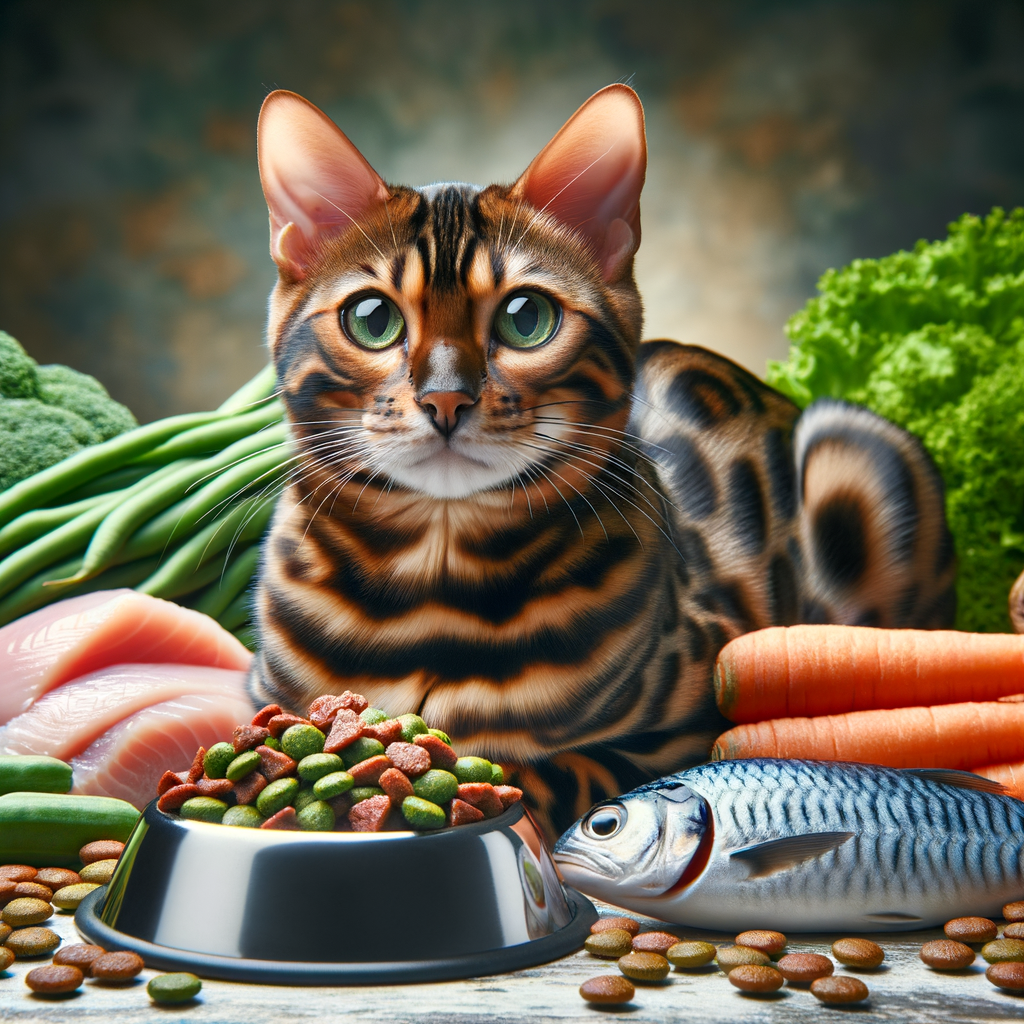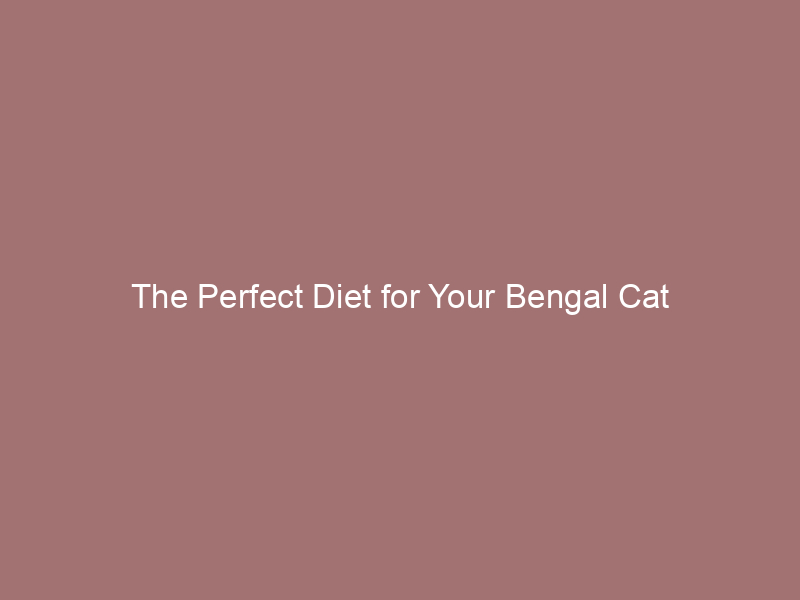
Introduction to Bengal Cat Nutrition
- Importance of a balanced diet for Bengal cats: It helps them stay healthy and active. Just like humans, cats need the right mix of proteins, fats, and carbohydrates. This ensures they get all the nutrients they need.
- Bengal cat dietary needs: Bengal cats have unique dietary needs. They are more active than many other cat breeds. This means they need more protein to support their muscles. They also need healthy fats for energy. Knowing what your Bengal cat needs can help you choose the best food for them.
The Best Food for Bengal Cats
Commercial Cat Food
- Benefits of commercial cat foodCommercial cat food is convenient and balanced. It contains all the nutrients Bengal cats need. These foods are made by experts who know what cats need to stay healthy. They often include vitamins, minerals, and proteins that are essential for your Bengal cat.
Another benefit is that commercial cat food is easy to store and serve. You don’t have to worry about preparing meals every day. Plus, it comes in different flavors, so your Bengal cat won’t get bored.
- Bengal cat food recommendations
Brand Type Key Benefits Royal Canin Bengal Dry Food Specially formulated for Bengal cats, supports healthy skin and coat Blue Buffalo Wilderness Wet Food High protein, grain-free, supports muscle growth Hill’s Science Diet Dry Food Balanced nutrition, supports digestive health
Homemade Cat Food
- Pros and cons of homemade cat food
- Essential ingredients in homemade cat food
Pros and Cons of Homemade Cat Food
Making cat food at home can be a great way to know exactly what your Bengal cat is eating. However, there are both pros and cons to consider.
| Pros | Cons |
|---|---|
| Control over ingredients | Time-consuming |
| Can be healthier | Requires knowledge of nutrition |
| No preservatives | Can be more expensive |
Homemade cat food allows you to avoid preservatives and artificial ingredients. You can choose high-quality meats and fresh vegetables. This can lead to a healthier diet for your Bengal cat.
However, making cat food at home can be time-consuming. You also need to understand feline nutrition to ensure your cat gets all the essential nutrients. Sometimes, homemade food can be more expensive than commercial options.
Ingredients in Homemade Cat Food
- Protein: Chicken, turkey, and fish are great sources of protein. Cats need protein to stay healthy and strong.
- Fats: Include healthy fats like fish oil or chicken fat.
- Vitamins and Minerals: Add supplements to ensure your cat gets enough vitamins and minerals. Consult your vet for recommendations.
- Water: Always include water or broth to keep your cat hydrated.
Make sure to use high-quality meats. Fats provide energy and help with nutrient absorption. Vitamins and minerals are crucial for overall health. Adding water or broth ensures your cat stays hydrated.
It’s always best to consult with your vet before starting a homemade diet for your Bengal cat. They can help you create a balanced meal plan.
Bengal Cat Feeding Guide
Feeding Schedule
- Feeding kittens: Kittens need more food because they are growing. Feed them 3-4 times a day. Use high-quality kitten food that is rich in protein and fat. This helps them grow strong and healthy.
- Feeding adult cats: Adult Bengal cats should be fed twice a day. Choose food that is balanced with protein, fat, and carbohydrates. Make sure it has all the vitamins and minerals they need.
- Feeding senior cats: Senior cats have different needs. They may need food that is easier to chew and digest. Feed them 2-3 times a day. Look for food that supports joint health and has fewer calories to prevent weight gain.
Portion Control
-
Portion Sizes
Cats have different needs based on their age, weight, and activity level. A good rule of thumb is to feed them about 20 calories per pound of body weight each day. For example, a 10-pound cat would need around 200 calories daily.
Cat’s Weight Daily Calories 5 lbs 100 calories 10 lbs 200 calories 15 lbs 300 calories -
Preventing Overfeeding and Obesity
Overfeeding can lead to obesity, which is a common problem in cats. Obesity can cause serious health issues like diabetes and heart disease. To prevent overfeeding, measure your cat’s food portions carefully. Use a measuring cup or a kitchen scale for accuracy.
Here are some tips to avoid overfeeding:
- Feed your cat at the same times each day.
- Avoid giving too many treats. Treats should make up no more than 10% of their daily calories.
- Provide plenty of playtime and exercise to keep your cat active.
Bengal Cat Diet Plan
Creating a Balanced Diet
- Protein sources for Bengal cats: Bengal cats are active and energetic, requiring a diet rich in protein. High-quality protein sources include chicken, turkey, and fish. These proteins help build and repair muscles, keeping your cat strong and agile.
- Importance of vitamins and minerals: Vitamins and minerals are essential for your Bengal cat’s overall well-being. For example, Vitamin A supports vision and immune function, while calcium strengthens bones and teeth. Ensure their diet includes a variety of nutrients to maintain optimal health.
Below is a table summarizing the key nutrients and their benefits:
| Nutrient | Benefit |
|---|---|
| Protein | Builds and repairs muscles |
| Vitamin A | Supports vision and immune function |
| Calcium | Strengthens bones and teeth |
| Omega-3 Fatty Acids | Promotes healthy skin and coat |
Special Dietary Needs
-
Diet for Overweight Bengal Cats
Overweight Bengal cats need a special diet to help them lose weight safely. Here are some tips:
- High Protein, Low Fat: Choose foods that are high in protein and low in fat. This helps maintain muscle while reducing fat.
- Portion Control: Measure your cat’s food to avoid overfeeding. Follow the feeding guidelines on the food package.
- Frequent Small Meals: Instead of one or two large meals, feed your cat smaller meals throughout the day.
- Exercise: Encourage your cat to play and be active. Use toys and climbing structures to keep them moving.
-
Diet for Bengal Cats with Health Issues
- Diabetes: A low-carb, high-protein diet can help manage diabetes. Avoid foods with high sugar content.
- Kidney Disease: Cats with kidney disease need low-phosphorus foods. Wet food is often better than dry food.
- Allergies: If your cat has allergies, try a limited-ingredient diet. Avoid common allergens like chicken or grains.
- Digestive Issues: For cats with sensitive stomachs, choose easily digestible foods. Look for foods with probiotics.
| Health Issue | Diet Tip |
|---|---|
| Overweight | High protein, low fat, portion control, frequent small meals, exercise |
| Diabetes | Low-carb, high-protein diet |
| Kidney Disease | Low-phosphorus foods, wet food |
| Allergies | Limited-ingredient diet, avoid common allergens |
| Digestive Issues | Easily digestible foods, probiotics |
Healthy Diet for Bengal Cats: Key Takeaways
- Importance of a Balanced DietIt helps them stay healthy and active. A good diet includes proteins, fats, vitamins, and minerals. These nutrients support their growth and energy needs.
- Choosing the Right FoodLook for high-quality cat food that lists meat as the first ingredient. Avoid foods with too many fillers like corn or soy. Wet food can be a good choice because it has more moisture.
- Feeding Guide and Portion ControlOverfeeding can lead to obesity, while underfeeding can cause malnutrition. Follow the feeding guide on the cat food package. Adjust portions based on your cat’s age, weight, and activity level.
- Creating a Diet PlanMake a diet plan for your Bengal cat. Include a mix of wet and dry food. Schedule regular feeding times. Monitor their weight and health, and adjust the diet as needed. Consult your vet for personalized advice.
Case Study: Optimal Diet for Bengal Cats
-
Case Study 1: Bengal Cat with Obesity
Meet Luna, a 5-year-old Bengal cat who struggled with obesity. Luna weighed 15 pounds, which is above the healthy range for her breed. Her owner, Jane, noticed that Luna was less active and had trouble jumping onto furniture.
Jane consulted a vet who recommended a high-protein, low-carb diet. Luna’s new diet included:
- Lean chicken breast
- Salmon
- Green beans
After six months, Luna lost 3 pounds and became more energetic. Jane also made sure Luna had regular playtime to keep her active.
Key Insight: A balanced diet with high protein and low carbs can help manage obesity in Bengal cats.
-
Case Study 2: Bengal Cat with Food Allergies
Max, a 3-year-old Bengal cat, had severe itching and digestive issues. His owner, Tom, took him to a vet who diagnosed food allergies. Max was allergic to common cat food ingredients like chicken and grains.
The vet suggested a novel protein diet. Max’s new diet included:
- Duck
- Peas
- Sweet potatoes
Within a few weeks, Max’s symptoms improved. He stopped itching and his digestion normalized.
Key Insight: Identifying and eliminating allergens from a Bengal cat’s diet can significantly improve their health.
Bengal Cat Food Tips
-
Introducing New Foods to Your Bengal Cat
When introducing new foods to your Bengal cat, do it slowly. Start by mixing a small amount of the new food with their current food. Gradually increase the amount of new food over a week.
This helps your cat get used to the new taste and texture. It also reduces the risk of stomach upset. Always monitor your cat for any signs of allergies or digestive issues.
-
Dealing with a Picky Eater
Some Bengal cats can be picky eaters. If your cat refuses to eat, try offering different types of food. Wet food, dry food, and raw food are all options. Sometimes, warming the food slightly can make it more appealing. Try to feed your cat at the same times each day. If your cat continues to be picky, consult your vet. There might be an underlying health issue.






